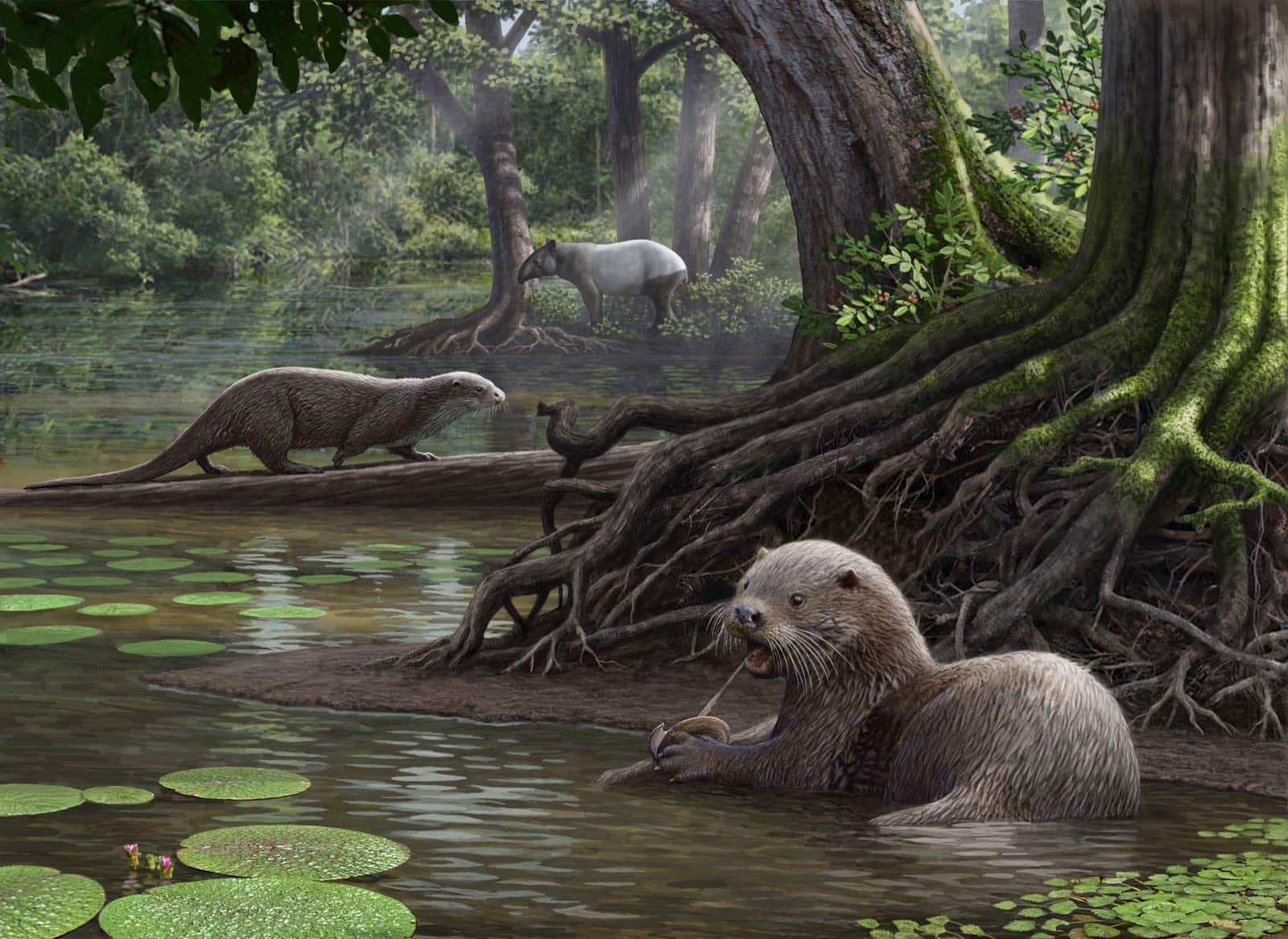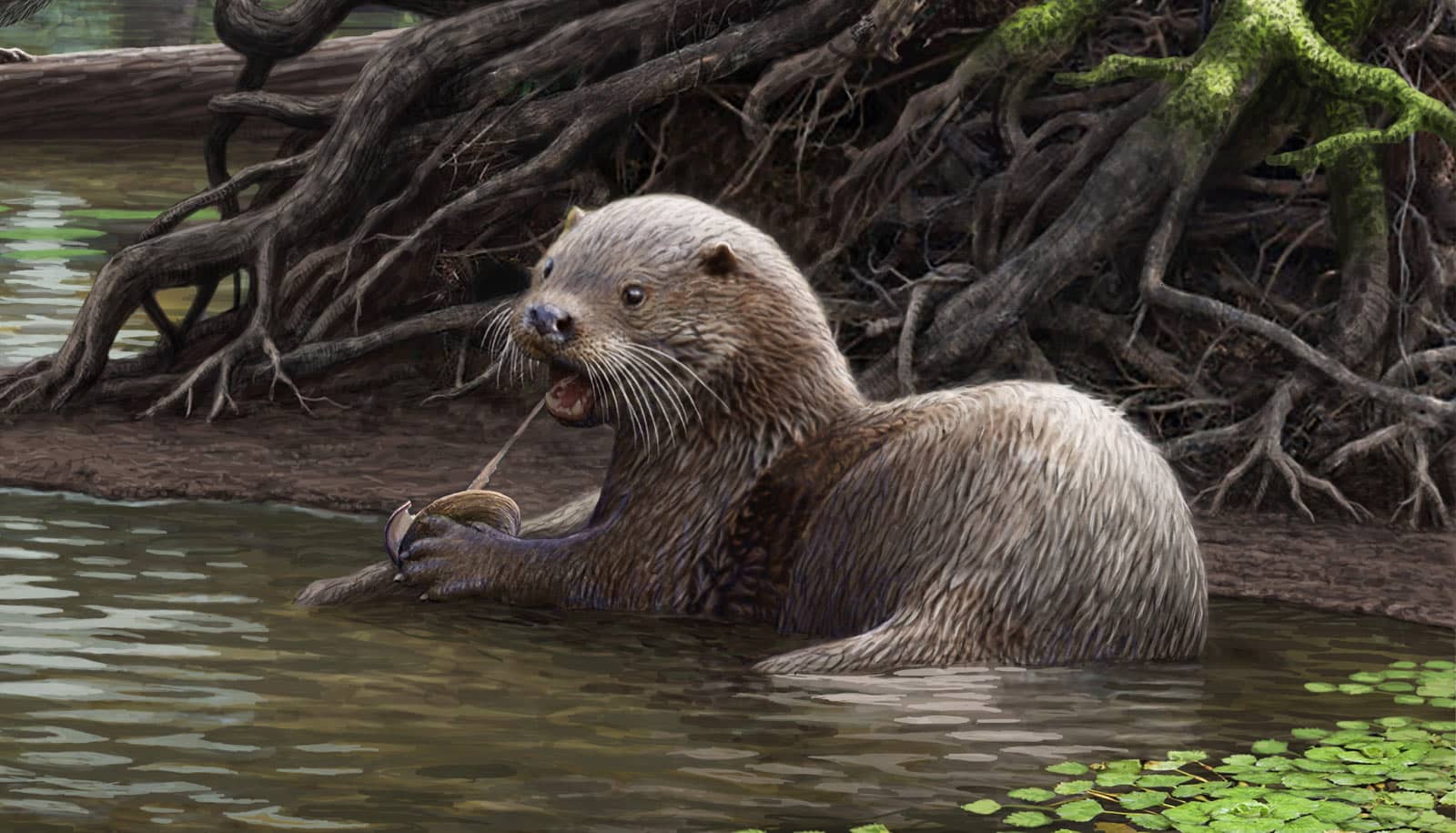A massive, wolf-sized otter that lived about 6 million years ago may have terrorized much larger prey with a surprisingly powerful bite, according to CT scans of its massive jaw.
The findings offer clues about how the oversized creature, weighing in at about 110 pounds, lived in the wetlands of southwest China.
“We started our study with the idea that this otter was just a larger version of a sea otter or an African clawless otter in terms of chewing ability, that it would just be able to eat much larger things. That’s not what we found,” says Z. Jack Tseng, an assistant professor of pathology and anatomical sciences at the University at Buffalo and a research associate with the American Museum of Natural History and the Natural History Museum of Los Angeles County.
“Our findings imply that Siamogale could crush much harder and larger prey than any living otter can.”
Scientists used computers to simulate how biting would strain Siamogale melilutra‘s jaws and discovered it had much firmer jaw bones than expected. This stiffness would have given the otter a surprisingly strong bite—even for its size.
“We don’t know for sure, but we think that this otter was more of a top predator than living species of otters are,” Tseng says. “Our findings imply that Siamogale could crush much harder and larger prey than any living otter can.”
Modern otters have a varied diet, with different species dining on foods including plants, rodents fish, crabs, and clams. But S. melilutra‘s jaws would have been strong enough to crush the shells of big mollusks or the bones of birds and small mammals like rodents, though what exactly it ate is unknown.

Bone-cracking jaws
To better understand S. melilutra, researchers compared the prehistoric critter to its living counterparts, using computed tomography (CT) scans of skulls to create 3D models showing how the jaw bones of 10 of the 13 known living otter species bend under biting forces. One rare otter was left out because researchers could not find bones to scan, and two others were excluded due to their similarity to other species.
“Carnivores are known to evolve powerful jaws, often for the purpose of cracking the bones of their prey.”
They also made a model for S. melilutra, using CT scans of fossils as a guide.
A comparison of all the otter jaw simulations revealed a linear relationship between jaw stiffness and animal size: Smaller otters had sturdier jaws. But S. melilutra was an outlier: The massive mammal’s modeled jaws were six times sturdier than expected. This strength, paired with the creature’s size, would have made it a formidable hunter.
“At the time that the otter lived, the area where its remains were found included a swamp or a shallow lake surrounded by evergreen forest or dense woodland,” says Denise F. Su, a paleoecologist at the Cleveland Museum of Natural History and one of the leaders of the Shuitangba Project that discovered the fossil otter.
“There was a diverse aquatic fauna at Shuitangba, including fish, crab, mollusks, turtles, and frogs, as well as many different species of water birds, all of which could have been potential prey for S. melilutra.”
In this wet and forested environment, the otter’s jaw power could have given it an edge over predators that couldn’t hunt in water or smash the shells of aquatic prey.
“Carnivores are known to evolve powerful jaws, often for the purpose of cracking the bones of their prey,” says Xiaoming Wang, a curator in the vertebrate paleontology department at the Natural History Museum of Los Angeles County. “In the shallow swamp of South China, it’s possible that an abundance of big clams drove these giant otters to acquire their rare traits, including their crushing teeth and robust jaws.”
Top predator
Besides providing insight into S. melilutra, the new study raises general questions about the relationship between jaw power and diet in animals.
“The strong jaws suggest that the primitive otter probably did not have the tool-using capability…”
Typically, scientists expect to find more powerful jaws in creatures that eat harder foods. But these two traits don’t match up in living otters: Jaw strength correlates with size, regardless of meal choice.
Tool use may help explain this discrepancy, allowing some otters with a relatively weak bite to tackle tough foods: “Sea otters, for example, swim on their backs and use their chests as a platform for crushing their food with stones,” Tseng says.
Tiny teeth suggest ancient otters trekked cross country
But tool use can’t completely account for the pattern that the scientists saw, and more research needs to be done to understand the unexpected trend.
It’s still possible to draw some conclusions about S. melilutra based on its unusual mandibular strength.
“We think the anatomy means something because it doesn’t fall within the usual pattern that we see in other otters,” he says. “The strong jaws suggest that the primitive otter probably did not have the tool-using capability, and combined with the giant size, it was likely a top predator.”
The US National Science Foundation, Yunnan Natural Science Foundation, Institute of Vertebrate Paleontology and Paleoanthropology, the National Natural Science Foundation of China, and the governments of Zhaotong and Zhaoyang funded the work.
Source: University at Buffalo



